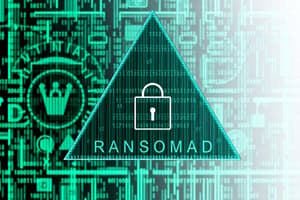Podcast
Questions and Answers
What is the primary focus of confidentiality in the context of the CIA Triad?
What is the primary focus of confidentiality in the context of the CIA Triad?
- Accessibility of assets at all times
- Limiting access to assets to authorized parties (correct)
- Modification of assets by any user
- Preserving the physical security of assets
Which of the following best describes integrity in the CIA Triad?
Which of the following best describes integrity in the CIA Triad?
- The ability to access data anytime without delay
- The assurance that data can be modified by anyone without restrictions
- The guarantee that data is always available to anyone who requests it
- The state in which assets can only be modified by authorized parties in authorized ways (correct)
In the context of confidentiality, what does 'access' encompass?
In the context of confidentiality, what does 'access' encompass?
- Interactions like reading, printing, and knowing the existence of the asset (correct)
- Only the ability to print or display data
- Only the ability to read data
- Preventing unauthorized users from knowing that an asset exists
Which term best describes a person, process, or program with respect to data access in the CIA Triad?
Which term best describes a person, process, or program with respect to data access in the CIA Triad?
What does the term 'availability' in the CIA Triad refer to?
What does the term 'availability' in the CIA Triad refer to?
Which of the following best defines computer security?
Which of the following best defines computer security?
What classification involves measures that allow recovery from damage to assets?
What classification involves measures that allow recovery from damage to assets?
Which scenario is an example of detection in the context of cyber security?
Which scenario is an example of detection in the context of cyber security?
What is a common prevention measure in the physical world as described?
What is a common prevention measure in the physical world as described?
What is the principle of Easiest Penetration in the context of security?
What is the principle of Easiest Penetration in the context of security?
What does preserving the integrity of an item imply?
What does preserving the integrity of an item imply?
Which aspect is NOT part of the integrity as recognized by Welke & Mayfield?
Which aspect is NOT part of the integrity as recognized by Welke & Mayfield?
What is meant by the availability of assets?
What is meant by the availability of assets?
How is availability sometimes referred to?
How is availability sometimes referred to?
Which definition applies to the concept of availability?
Which definition applies to the concept of availability?
What does the 'A' in the AAA framework stand for?
What does the 'A' in the AAA framework stand for?
What is the primary focus of the AAA system?
What is the primary focus of the AAA system?
Which of the following describes a legitimate user in the context of authentication?
Which of the following describes a legitimate user in the context of authentication?
Which one of the following is NOT an acceptable modification of an item?
Which one of the following is NOT an acceptable modification of an item?
What ensures that errors in data can be identified and corrected?
What ensures that errors in data can be identified and corrected?
Confidentiality ensures that assets can be modified by any party regardless of authorization.
Confidentiality ensures that assets can be modified by any party regardless of authorization.
Integrity refers to the ability to create, modify, or delete assets only by authorized parties in authorized ways.
Integrity refers to the ability to create, modify, or delete assets only by authorized parties in authorized ways.
Access in the context of confidentiality only includes reading and viewing documents.
Access in the context of confidentiality only includes reading and viewing documents.
Availability ensures that authorized parties can access assets whenever they need them without delay.
Availability ensures that authorized parties can access assets whenever they need them without delay.
The CIA Triad refers only to the viewpoint of the user regarding data security.
The CIA Triad refers only to the viewpoint of the user regarding data security.
Computer security only includes the protection of hardware and software.
Computer security only includes the protection of hardware and software.
In the context of computer security, the classification of prevention involves measures like encryption when making online purchases.
In the context of computer security, the classification of prevention involves measures like encryption when making online purchases.
Detection in cybersecurity refers to recovering assets after they have been damaged.
Detection in cybersecurity refers to recovering assets after they have been damaged.
Calling the police after a theft is an example of prevention in the context of physical security.
Calling the police after a theft is an example of prevention in the context of physical security.
A burglar alarm that activates during a break-in is an example of a detection measure.
A burglar alarm that activates during a break-in is an example of a detection measure.
Integrity can only mean being unmodified and precise.
Integrity can only mean being unmodified and precise.
Availability refers to the accessibility of assets to unauthorized parties.
Availability refers to the accessibility of assets to unauthorized parties.
The AAA framework is used to manage user access and enforce user policies.
The AAA framework is used to manage user access and enforce user policies.
Error detection and correction are recognized aspects of integrity by Welke & Mayfield.
Error detection and correction are recognized aspects of integrity by Welke & Mayfield.
Denial of service (DoS) is a term associated with availability.
Denial of service (DoS) is a term associated with availability.
An item can be modified in any way and still maintain its integrity.
An item can be modified in any way and still maintain its integrity.
Consistency is not a factor in determining the integrity of an item.
Consistency is not a factor in determining the integrity of an item.
Authorized actions are essential for maintaining integrity as defined by Welke & Mayfield.
Authorized actions are essential for maintaining integrity as defined by Welke & Mayfield.
Integrity can be achieved solely through computer systems without real-world implementation.
Integrity can be achieved solely through computer systems without real-world implementation.
The definition of availability includes being present in a non-usable form.
The definition of availability includes being present in a non-usable form.
Flashcards
Prevention in Security
Prevention in Security
Measures taken to stop damage to an asset before it happens. Like installing locks or using encryption.
Detection in Security
Detection in Security
The process of identifying when, how, and by whom an asset was damaged or compromised. Including things like detecting unauthorized transactions or system changes.
Reaction in Security
Reaction in Security
Steps taken after a security breach or damage to an asset to recover or minimize the damage. Could involve replacing data, changing passwords, or reporting a crime.
Principle of Easiest Penetration
Principle of Easiest Penetration
Signup and view all the flashcards
Assets in Computer Systems
Assets in Computer Systems
Signup and view all the flashcards
Confidentiality
Confidentiality
Signup and view all the flashcards
Integrity
Integrity
Signup and view all the flashcards
Availability
Availability
Signup and view all the flashcards
CIA Triad
CIA Triad
Signup and view all the flashcards
Subject
Subject
Signup and view all the flashcards
Data Integrity
Data Integrity
Signup and view all the flashcards
Authentication
Authentication
Signup and view all the flashcards
Authorization
Authorization
Signup and view all the flashcards
Authorized Actions
Authorized Actions
Signup and view all the flashcards
Separation and Protection of Resources
Separation and Protection of Resources
Signup and view all the flashcards
Error Detection and Correction
Error Detection and Correction
Signup and view all the flashcards
AAA System
AAA System
Signup and view all the flashcards
Denial of Service (DoS)
Denial of Service (DoS)
Signup and view all the flashcards
Easiest Penetration Principle
Easiest Penetration Principle
Signup and view all the flashcards
What are computer system assets?
What are computer system assets?
Signup and view all the flashcards
What is prevention in security?
What is prevention in security?
Signup and view all the flashcards
What is detection in security?
What is detection in security?
Signup and view all the flashcards
What is reaction in security?
What is reaction in security?
Signup and view all the flashcards
Separation & Protection of Resources
Separation & Protection of Resources
Signup and view all the flashcards
Error Detection & Correction
Error Detection & Correction
Signup and view all the flashcards
Study Notes
Chapter 1: Basic Security Concepts
- Computer security is the protection of computer system assets (items that have value).
- Asset types include hardware, software, data, processes, storage media, and people.
- The principle of easiest penetration means intruders will exploit the easiest available means.
Introduction
- Computer systems (hardware, software, and data) have value and need protection.
- Security protection is categorized into three areas:
- Prevention: measures that stop damage
- Detection: measures to identify when and how an asset is damaged.
- Reaction: measures for recovering assets or damage.
- Physical world examples of these: prevention (locks), detection (alarms, cameras), reaction (repair, contacting police).
- Cyber world example of these: prevention (encryption), detection (unauthorized transactions), reaction (new card, recovering losses).
Security Goals - CIA Triad
- Confidentiality: Assets are only accessible to authorized parties (secrecy, privacy).
- Integrity: Assets can only be modified by authorized parties in authorized ways (accuracy, precision, unmodified, consistent, internally consistent, meaningful).
- Availability: Assets are accessible to authorized parties when needed without any delay (capacity, performance, usability).
- Security is achieved through a combination of these three areas, from the asset's point of view, not the user's.
Confidentiality
- Ensures that computer-related assets are accessed only by authorized parties.
- Also involves viewing, printing, and knowing that the asset exists, not just reading.
- A general pattern is that a person, process, or program is authorized to access a data item in a specific way. Subjects are the person/process/program; Objects are the data item; access modes are operations (read, write, execute); policies are the authorizations.
Integrity
- Assets can be modified only by authorized parties in authorized ways.
- Modification includes writing, changing status, deleting, and creating.
- Integrity means different things in various contexts (accurate, precise, unmodified).
- Specifically, authorized actions, separation and protection of resources, and error detection and correction are components of integrity. Welke & Mayfield recognize these three particular aspects.
Availability
- Assets are accessible to authorized parties at appropriate times.
- Access to particular sets of objects should not be prevented from person/system who has legitimate access.
- Availability is also characterized by its opposite, denial-of-service (DoS).
- Availability applies both to data and services and depends on capacity to meet needs. Availability is sometimes known by its opposite - denial of service (DoS). Definition of availability depends on these points: having enough capacity to meet service needs, being accessible to authorized parties at appropriate times, and not being prevented from people/systems with legitimate access to particular objects.
Other Protection Requirements
- The AAA (Authentication, Authorization, Accounting) system is from the user's perspective, not the asset's.
- It manages user access, enforces policies and privileges, and measures network resource consumption. Authentication determines who the user is, Authorization defines what the user can do, and Accounting tracks user activities and events.
Vulnerabilities and Threats
- A vulnerability is a weakness in a system's design, implementation, or procedures that can be exploited.
- Threats to a computing system are circumstances that have the potential to cause loss or harm.
- Security threats include interception, interruption, modification, and fabrication.
Computer Network Vulnerabilities
- Various vulnerabilities are listed relating to hardware, software, communication, and access controls. Specific vulnerabilities are identified in the context of hardware, software, communication lines and access controls.
Security Threats
- The CIA triad can be viewed from a different perspective, focusing on different types of harm caused to assets.
- Harm types are interception, interruption, modification, and fabrication. Detailed examples are provided in the notes and are linked back to the threats.
Examples of Security
- Examples are provided to illustrate interception, interruption, modification, and fabrication. The notes describe how these threats manifest in practical terms and involve examples such as destroying a hard disk, wiretapping, altering data files, adding records to a file, and inserting spurious messages in a network.
Studying That Suits You
Use AI to generate personalized quizzes and flashcards to suit your learning preferences.




